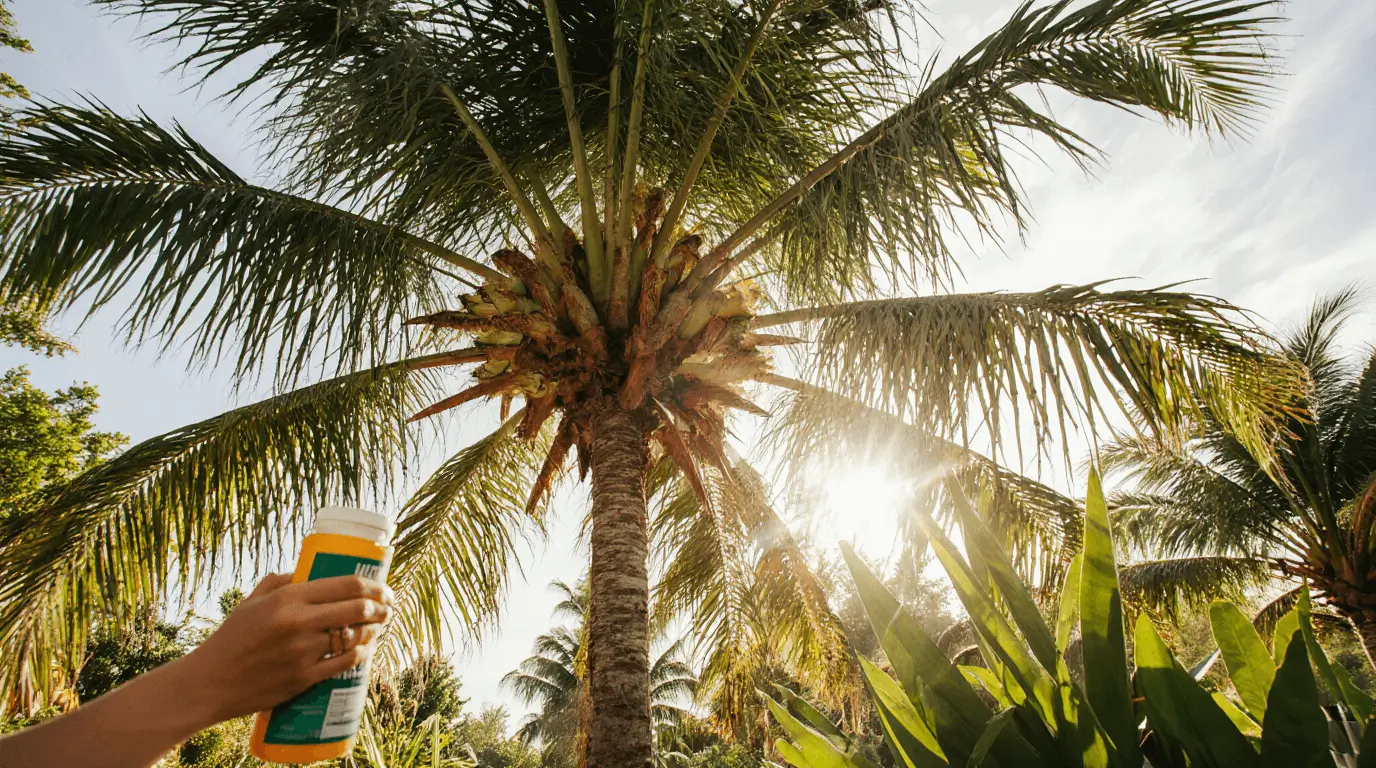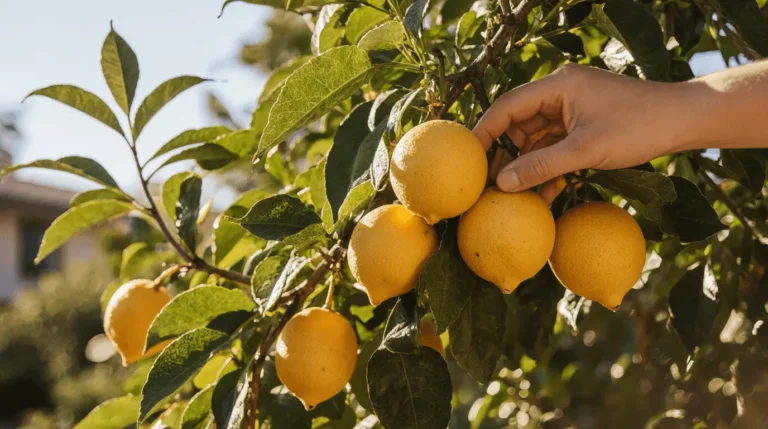Growing a coconut palm is one of the greatest joys for anyone who loves nature and gardening. These majestic trees bring a tropical touch and stunning visual attraction to any space, making them a top pick for those who adore beauty and versatility. The care of coconut tree thrives in hot days and sandy soil, showing true adaptability and steady growth through proper cultivation. Each island plant offers refreshing coconut water, cool water, and succulent flesh used in delectable dishes.
The rich coconut oil nourishes skin and hair, while the coconut fruit, palm leaves, and natural nutrition bring endless benefits. Beyond being a tropical trend, these trees symbolize life, resilience, and the soothing rhythm of coastal living.
Quick Care Guide for Coconut Palm
| Aspect | Care Tips |
| Watering | Keep soil slightly moist but avoid overwatering to prevent root rot. |
| Soil | Choose well-draining, sandy-loamy soil, the preferred type for steady growth. |
| Fertilization | Use palm-specific fertilizer every 2-3 months to support healthy development. |
| Sunlight | Provide full sunlight for at least 6+ hours daily to help the palm thrive. |
| Pruning | Regular pruning keeps it neat; remove yellow fronds and remove brown fronds promptly. |
| Pest Control | Regularly inspect for pests and apply organic solutions when needed. |
| Harvesting | Wait for a brown husk and listen for a sloshing sound before picking coconuts. |
| Temperature | Maintain warmth between 85-95°F (29-35°C) for optimal growth. |
| Spacing (if multiple) | Keep multiple palms 5 meters apart for proper air and root space. |
Read Also: 7 Secrets to Growing Cashew Trees in Florida | Expert Tips
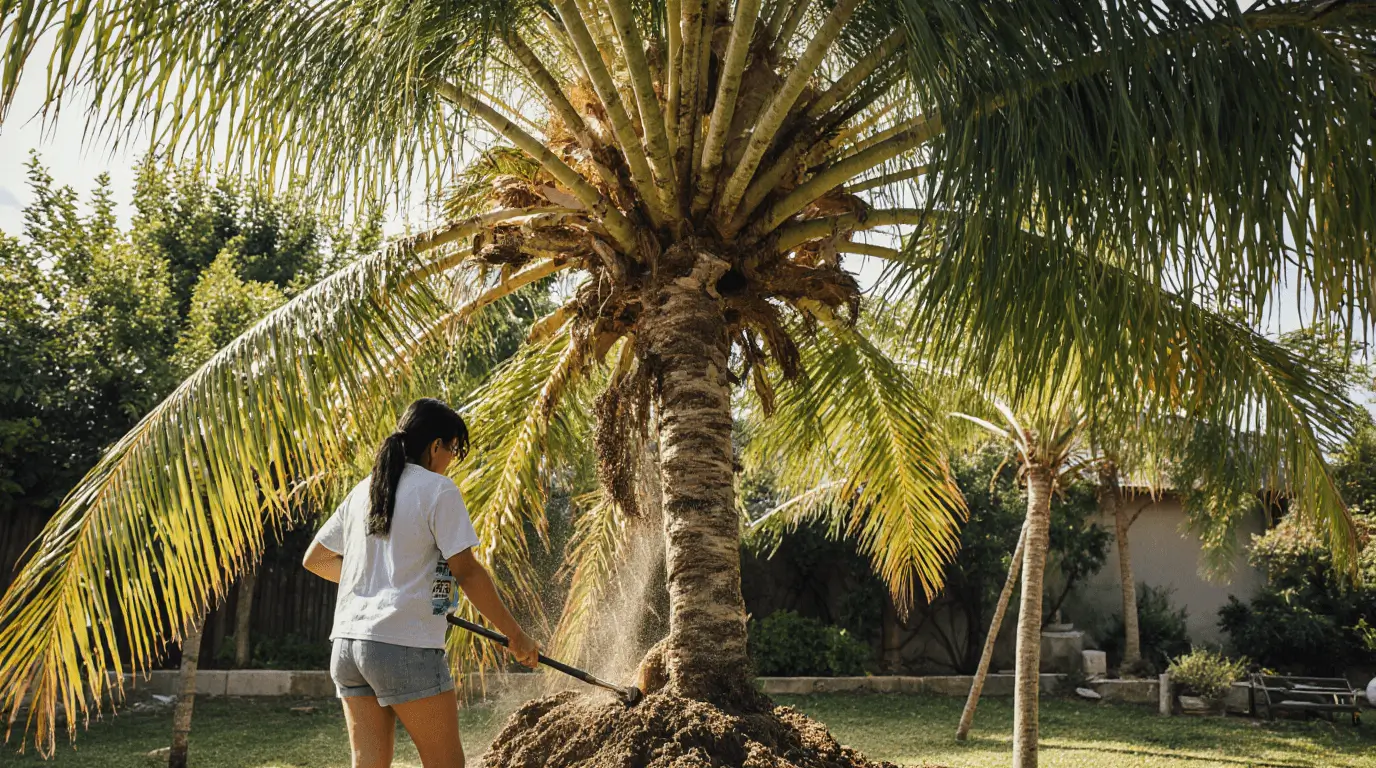
Ideal Conditions for Growing a Coconut Palm
When growing a coconut palm, think of the serene beaches and tropical paradises it resembles. This tropical plant thrives in a warm climate with balanced humidity, rich moisture, and sandy soil near a coastal region. With proper care, cultivation, and nourishment, the tree reaches its full potential, adapting to its natural habitat and environment for healthy growth under bright sunlight and ideal temperature conditions found in tropical weather and nature.
Read Also: 7 Secrets to Growing a Lychee Tree in Your Zone
Temperature Requirements
For a coconut palm to flourish, maintaining the right temperature is absolutely crucial. This tropical tree prefers a warmth that stays within the ideal range of 27 ± 5°C, or about 85-95°F in degrees Fahrenheit. In my experience, the palm tends to thrive when the climate provides heat and consistency, creating optimal conditions for steady growth. A balanced environment that mimics natural coastal warmth helps the palm maintain its strength and beauty all year round.
Light and Sun Exposure
A healthy coconut palm needs plenty of sunshine and direct sunlight for at least six hours each day to grow strong. Whether your coconut tree is outdoors or indoors, make sure it’s placed where it can bask in abundant sunlight and natural light. In my experience, tropical palms truly enjoy the brightness and warm rays that boost photosynthesis and overall growth. A lack of sun can hamper development, so maintaining the right light exposure is ideal for their long-term health and strength.
Soil Type and pH
The soil plays a key role in helping coconut palms grow and thrive. These versatile trees adapt well to sandy, loamy, or clayey soils, whether slightly acidic or mildly alkaline, showing great flexibility in different soil types. From my experience, maintaining a pH between 6.4 to 7.0 within the broader range of 5.0 to 8.0 provides the right balance for healthy roots, good drainage, and steady moisture levels. In a soggy garden patch, a raised bed helps prevent excess wetness and supports the structure, texture, nutrients, and overall composition of the garden soil for consistent growth.
Read Also: Fast Producing Fruit Trees, Shrubs & Vines
Watering Needs
A coconut plant needs plenty of water to grow strong and healthy, especially during its first year after transplantation. To enjoy juicy coconuts, give your coconut tree around 15-30 gallons of fresh water daily, ensuring enough moisture and hydration for steady growth and nourishment.
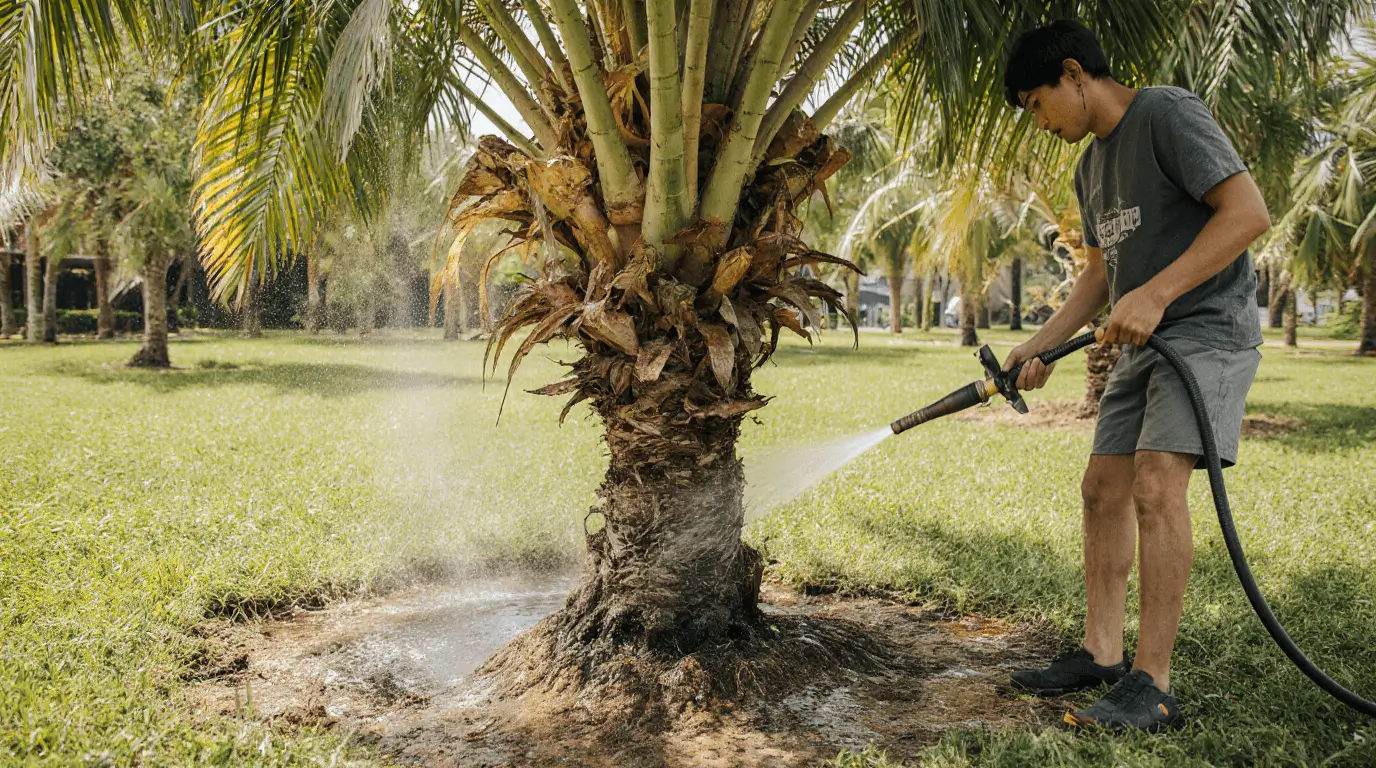
If it’s an ornamental tree in your home garden, an inch of rain or a gentle spray once a week can maintain ideal conditions. With proper care, a balanced watering schedule, and regular maintenance, you can create a fruitful tropical feel right at your doorstep in the tropics.
Selecting a Coconut
- To check freshness, do the slosh test — simply shake the coconut and listen for a slosh sound inside. A clear slosh means it’s fresh, ready, and has good viability for planting. Always prioritize quality during selection to ensure healthy growth and strong planting material.
- Keep the husk intact because it protects the seed, aids moisture retention, and supports the germination process. When buying a coconut tree for sale, choose one with a firm husk—its natural protection helps maintain preparation and overall plant health.
Germination
- The container method is a simple way to start your coconut palm. Fill a container with water and place the coconut in it, ensuring the pointed end is facing up. This allows you to watch the sprouting process and helps the seed develop into a growing coconut tree.
- Another option is the direct soil method, which follows nature’s way. Plant the coconut in soil with the pointed end facing down. This mimics how palm trees naturally germinate, giving the coconut a chance to grow as it would in the wild.
- Germination can take anywhere from 3 to 6 months, and during this time, patience is key. You’ll start to see a sprout emerging from the coconut, followed by roots anchoring into the soil, marking the beginning of the seedling development and growth.
Read Also: How to Grow a Eucalyptus Tree from Cutting
Transplanting to a Permanent Location
- When picking the ideal spot for your coconuts, choose a location that gets ample sun. This will ensure your coconut tree grows robustly and thrives in its new home.
- For planting, dig a hole deep enough to cover the seed and provide enough growth room. If you’re planting multiple coconut trees for sale, make sure to space them at least 5 meters apart for proper spacing.
- After transplant, give your coconut tree initial care by keeping the soil moist but not waterlogged. The first few weeks are critical for successful growth. Proper gardening routine will help your coconut tree thrive and establish itself.
Maintenance and Care
Taking care of a coconut plant requires diligence and an understanding of its unique needs. To help it thrive as a centerpiece in your garden, focus on proper fertilization, watering, and pruning.
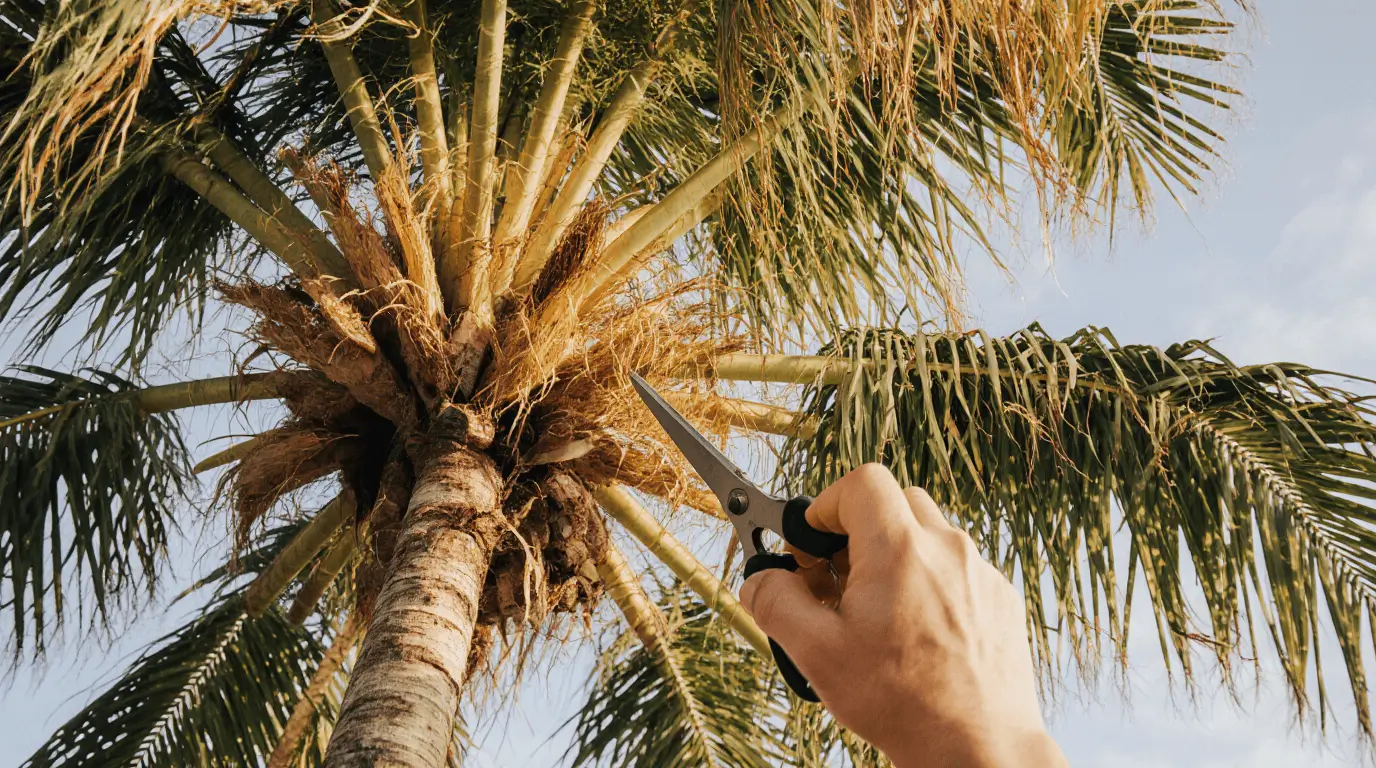
- Use palm-specific fertilizer every 2-3 months, ensuring it gets the right nutrients like potassium, magnesium, and iron.
- Keep the soil moist but not soggy, and water deeply once a week to maintain the balancing act between moisture and drainage.
- Regular pruning of yellow fronds and brown fronds helps maintain the appearance and energy of the plant, preventing it from wasting resources on dying parts.
Read Also: Tree Insect Management
Harvesting and Using Coconuts
As your coconut tree reaches its prime and the clusters of coconuts are ready for harvest, it’s important to recognize when they are mature. These coconuts will be larger and have a rich brown husk. To harvest from the coconut palm tree, you can either climb the tree carefully or use long poles with a cutting edge for a safer harvesting technique. With the right tool, you can enjoy the fruit and its size, ensuring a successful coconut harvest.
Potential Challenges and Solutions
When caring for a coconut tree, you might face some hiccups along the way. Root rot, often caused by waterlogged soil, can harm the tree health, so it’s important to ensure proper drainage and avoid overwatering. If you notice yellowing leaves, it could mean a nutrient deficiency, so make sure to fertilize regularly and monitor soil health. If there are holes in the coconuts, this could be a sign of pest infestations. Keep an eye out for unwanted critters and consider using organic pest solutions to prevent further damage. With the right tree care and attention, these challenges can be managed effectively, ensuring your coconut tree’s continued growth and health.
Read Also: Troubleshoot Common Fruiting Issues
Conclusion
Maintaining a coconut tree requires attention to common challenges, such as root rot, nutrient deficiencies, and pest infestations. By ensuring proper drainage, regular fertilization, and monitoring for pests, you can keep your coconut tree thriving. Consistent tree care and maintenance are key to overcoming obstacles and promoting healthy growth. With the right approach, your coconut tree will continue to flourish in its environment.
FAQs
- What causes root rot in coconut trees?
Root rot is caused by waterlogged soil. Ensure your coconut tree has proper drainage to avoid stagnant water around the roots. - How often should I fertilize my coconut tree?
Fertilize your coconut tree every 2-3 months to provide it with the necessary nutrients for healthy growth and development. - What are some natural ways to control pests on coconut trees?
You can use organic pest solutions like neem oil or insecticidal soap to manage pest infestations on your coconut tree. - How can I tell if my coconut tree is suffering from a nutrient deficiency?
If the leaves of your coconut tree start yellowing, it could be a sign of a nutrient deficiency, requiring fertilization and monitoring soil health.

